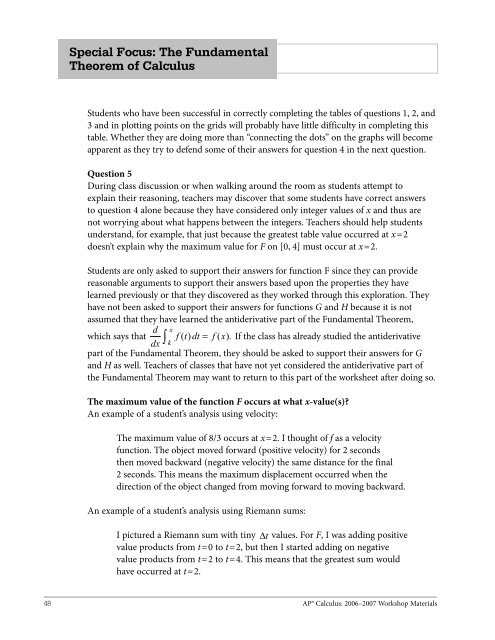AP Calculus
You also want an ePaper? Increase the reach of your titles
YUMPU automatically turns print PDFs into web optimized ePapers that Google loves.
Special Focus: The Fundamental<br />
Theorem of <strong>Calculus</strong><br />
Students who have been successful in correctly completing the tables of questions 1, 2, and<br />
3 and in plotting points on the grids will probably have little difficulty in completing this<br />
table. Whether they are doing more than “connecting the dots” on the graphs will become<br />
apparent as they try to defend some of their answers for question 4 in the next question.<br />
Question 5<br />
During class discussion or when walking around the room as students attempt to<br />
explain their reasoning, teachers may discover that some students have correct answers<br />
to question 4 alone because they have considered only integer values of x and thus are<br />
not worrying about what happens between the integers. Teachers should help students<br />
understand, for example, that just because the greatest table value occurred at x=2<br />
doesn’t explain why the maximum value for F on [0, 4] must occur at x=2.<br />
Students are only asked to support their answers for function F since they can provide<br />
reasonable arguments to support their answers based upon the properties they have<br />
learned previously or that they discovered as they worked through this exploration. They<br />
have not been asked to support their answers for functions G and H because it is not<br />
assumed that they have learned the antiderivative part of the Fundamental Theorem,<br />
d x<br />
which says that f t dt f x<br />
dx<br />
∫ ( ) = ( ). If the class has already studied the antiderivative<br />
k<br />
part of the Fundamental Theorem, they should be asked to support their answers for G<br />
and H as well. Teachers of classes that have not yet considered the antiderivative part of<br />
the Fundamental Theorem may want to return to this part of the worksheet after doing so.<br />
The maximum value of the function F occurs at what x-value(s)?<br />
An example of a student’s analysis using velocity:<br />
The maximum value of 8/3 occurs at x=2. I thought of f as a velocity<br />
function. The object moved forward (positive velocity) for 2 seconds<br />
then moved backward (negative velocity) the same distance for the final<br />
2 seconds. This means the maximum displacement occurred when the<br />
direction of the object changed from moving forward to moving backward.<br />
An example of a student’s analysis using Riemann sums:<br />
I pictured a Riemann sum with tiny ∆t values. For F, I was adding positive<br />
value products from t=0 to t=2, but then I started adding on negative<br />
value products from t=2 to t=4. This means that the greatest sum would<br />
have occurred at t=2.<br />
48<br />
<strong>AP</strong>® <strong>Calculus</strong>: 2006–2007 Workshop Materials


